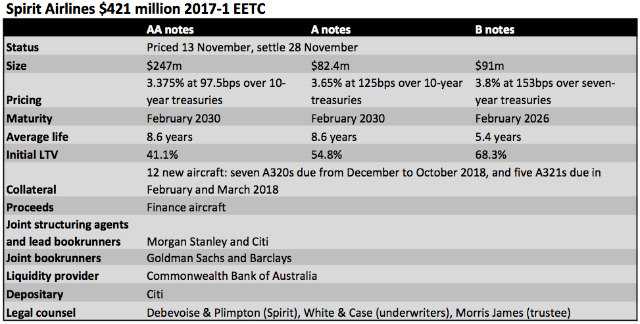The day that American Airlines priced a B notes add-on to its 2016-3 enhanced equipment trust certificates (EETC) transaction changed the course of the aircraft capital markets for the year.
On that date, 20 September, the Fort Worth-based carrier corrected what some called a mispricing of EETC B tranches in the market, with the notes coming in at 193bps over five-year US treasuries for a coupon of 3.75% on the $193 million issue.
"We'd been frustrated for quite a while that B tranches had been mispriced and, finally, they're where they should be compared to unsecured," said Gerry Laderman, treasurer of United Airlines, in October. That month, the carrier followed American with two separate B note transactions of its own totaling $495 million in junior debt.
Spirit Airlines was also watching. When the first American transaction hit the market, the Florida-based ultra low-cost carrier was leaning towards bank debt to finance the 12 aircraft covered by a request for proposals that it sent to the market over the summer, says Simon Gore, treasurer of Spirit, in an interview with FlightGlobal.
"It looked like bank debt until United and American repriced the B tranche EETC market," he says. "We took another look at the capital markets."
What Spirit saw was a "supply and demand imbalance" in the EETC market, says Gore. American and United had issued the only new paper in the market since Norwegian's Torefjorden DAC transaction in May 2016, which created significant demand for another credit.
Spirit put together documentation for a EETC in just four weeks before launching its $421 million 2017-1 notes on 13 November, he says.
Investors bit.
The $247 million 2017-1 AA notes priced at a spread of 97.5bps over 10-year US treasuries with a coupon of 3.375%, the $82.4 million A notes at 125bps over 10-year US treasuries for a 3.65% coupon, and the $91 million B notes at 153bps over seven-year treasuries carrying a 3.8% coupon.
The pricing on Spirit's AA and A tranches was tighter than that on the last such transactions in the market, American's 2017-2 notes in July, and the B tranche was only 10bps wider than the 143bps over seven-year US treasuries that United got for its 2016-1 B and 2016-2 B notes in October.
"The appetite was there for our paper, everyone has had their fill of American and United and were hungry for some diversification," says Gore, adding that at its peak the transaction was 4.7x oversubscribed.

Morgan Stanley and Citi are joint structuring agents and joint lead bookrunners of Spiit's 2017-1 transaction. Goldman Sachs and Barclays are joint bookrunners.
GREAT DEAL
The EETC was also "a great deal for the company compared to bank debt", says one capital markets lender on the transaction. Asked whether he agrees with this, Gore says he does noting that the average spread on the 2017-1 notes comes close to the pricing over Libor for a secured aircraft loan.
Spirit lists three bank loans on its balance sheet: $426 million in senior term loans due in 2029 at a fixed rate of 4.1%, $41.3 million in junior term loans due in 2022 at 6.9% and $363 million in loans due in 2029 at 3.82%.
Even the cheapest of those three loans is more expensive than the 3.499% blended interest rate on the 2017-1 notes.
PRE-FUNDING
Spirit financed 12 Airbus A320 family aircraft, including seven A320s and five Airbus A321s, with the 2017-1 transaction. The collateral has an aggregate appraised value of $573 million, the prospectus shows.
While two of the A320s will arrive in December, the deal pre-funds all 10 of the airline's 2018 deliveries. Of those, seven aircraft – two A320s and five A321s – are due in the first four months of the year.
This front end-heavy delivery schedule minimises the negative carry costs of the capital markets debt to the point of being roughly equivalent to the commitment fees associated with bank loans, says Gore.
With all of its 2018 deliveries financed, Spirit is unlikely to look to the market for 2019 funding until the middle of next year, he says. It is likely to consider all options, including the capital markets, banks and sale-and-leasebacks, at the time.
"We're extremely happy with the results," says Gore of the 2017-1 transaction.
Source: Cirium Dashboard






















